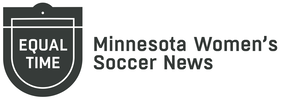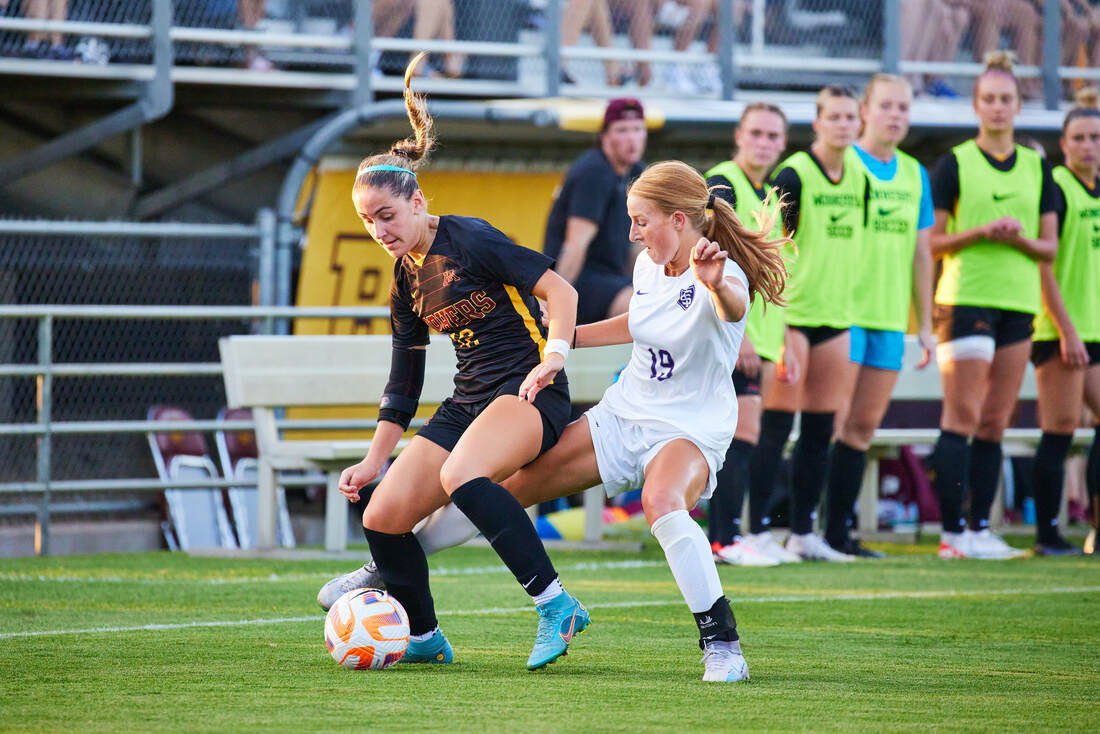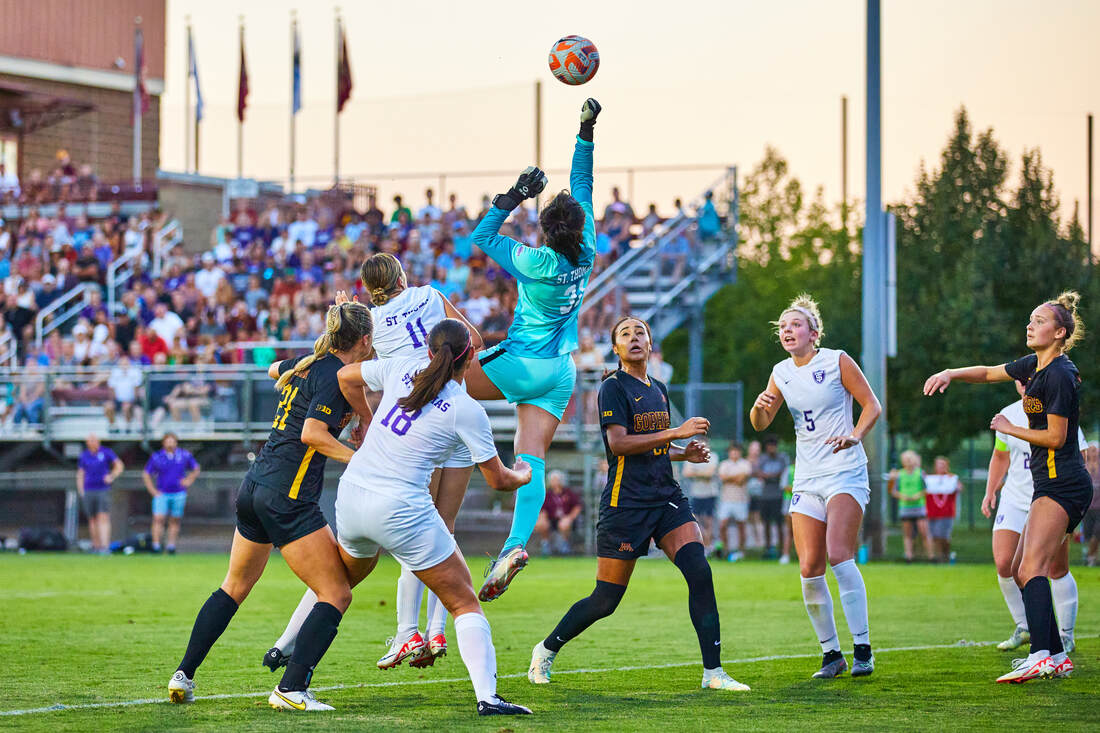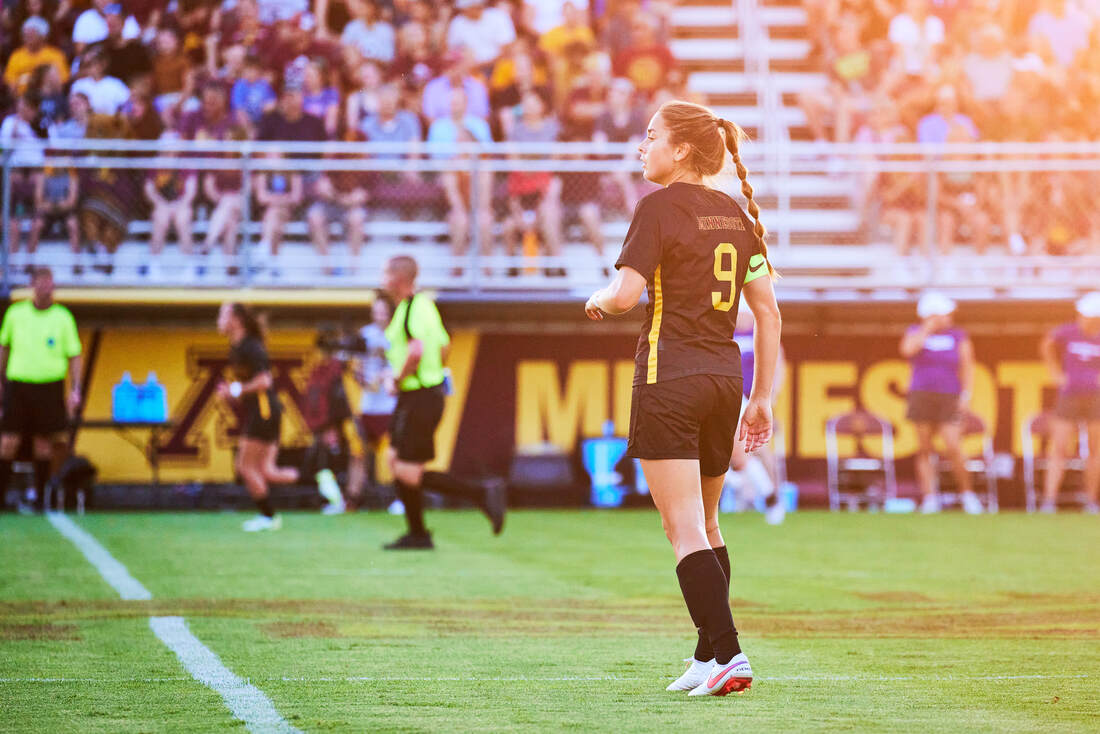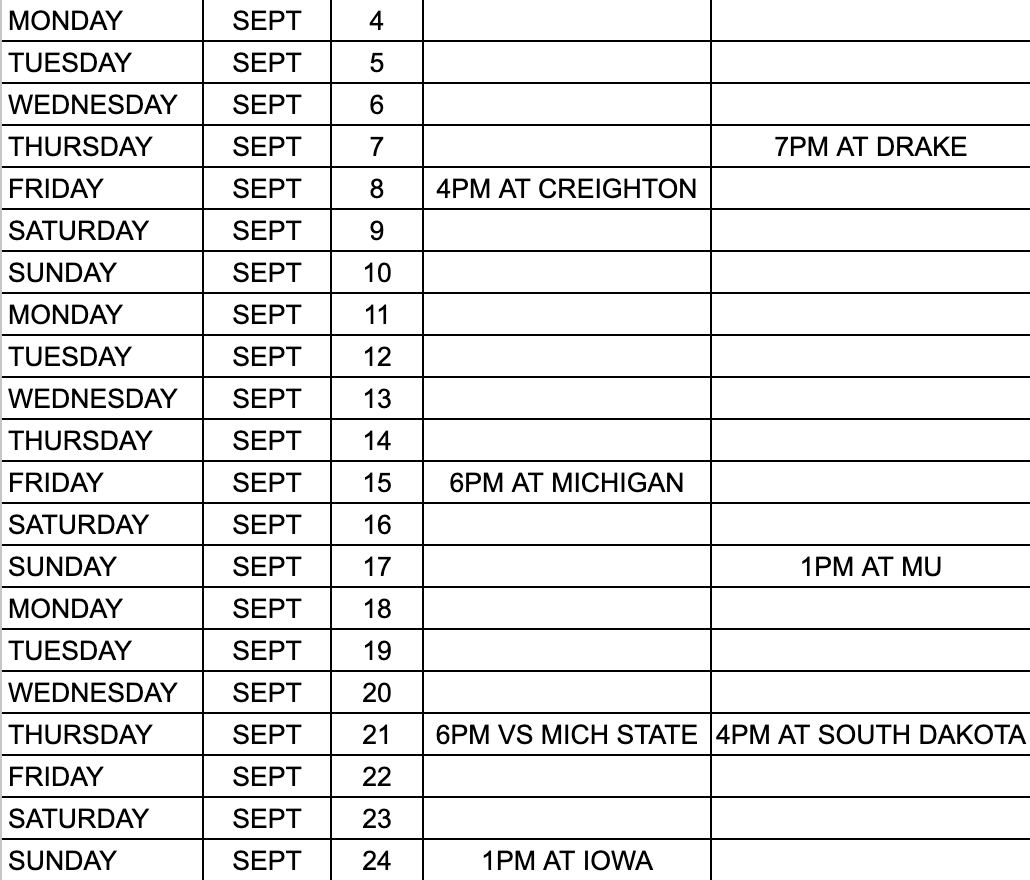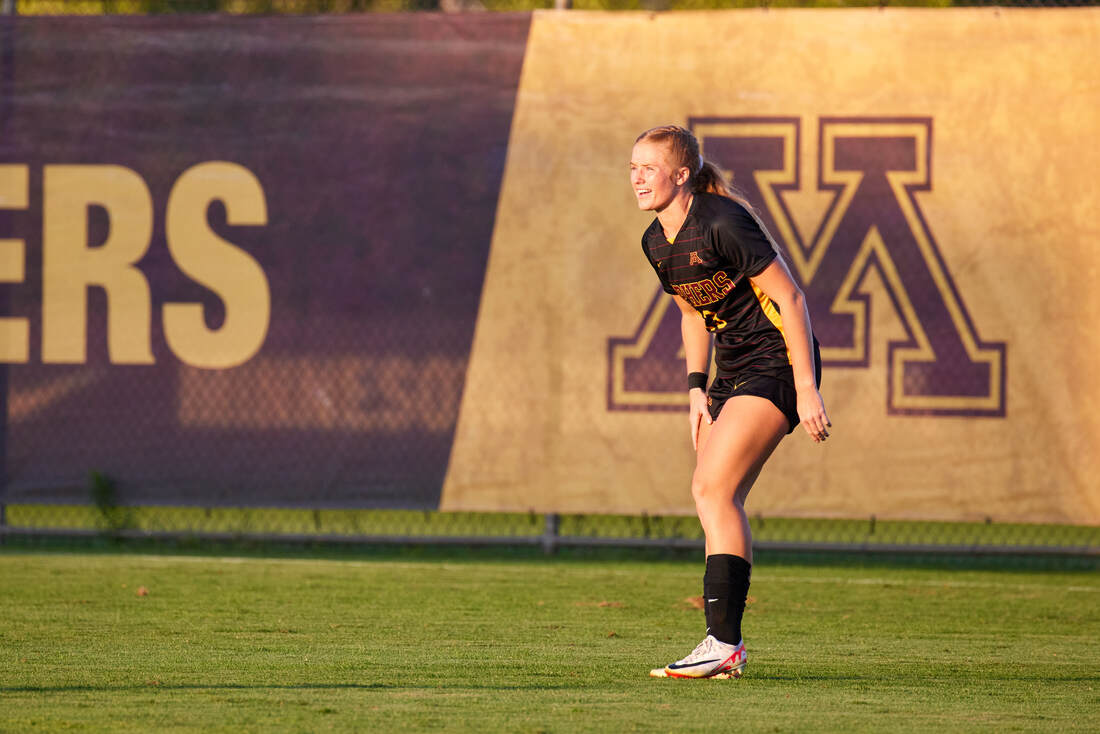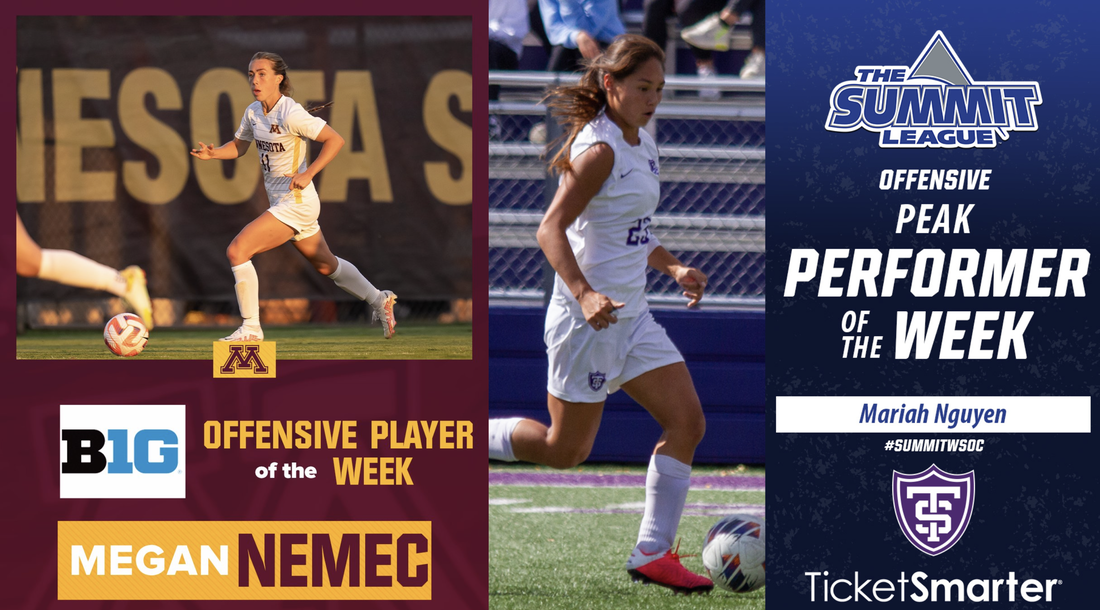|
Matt Privratsky sits down with Gopher Soccer's star centerbacks Elizabeth Overberg and Jordy Rothwell to talk about their strong performance in the run of play, Overberg's growth during her time in MN, Rothwell's experience with the Gophers after years at Creighton, how they're preparing for Big Ten play, and two pop quizzes on the Midwest and their coaches & players.
You can watch the show below or you can listen to it as a podcast on Soundcloud, iTunes, Google Play, or Stitcher. Show presented by Pentz Homes (pentzhomes.com) and Modist Brewing (modistbrewing.com)
0 Comments
Matt Privratsky
The Gophers and Toms have now played the bulk of their non-conference slate and we’re starting to see more and more of who these squads are in 2023. Before I head out on the road to cover their games in person (St Thomas at Drake Thursday, Minnesota at Creighton Friday), let’s go over a few trends to note for Minnesota’s Division I women’s soccer programs following their first ever regular season matchup.
Wins to Ties, Ties to Losses As much as I praised the Gophers hard fought tie on the road against a top SEC foe in #22 Georgia, Minnesota saw it as a game they really could have won. When I chatted with freshman standout Kate Childers before her video interview after their 5-0 win over St Thomas, the first thing she (and Head Coach Erin Chastain) mentioned about the Georgia game was that they have to aim for more. And though a tie against a top team will certainly be valuable for Minnesota in building a post season resume, the result does fit into a trend we've mentioned before: letting wins turn into ties and letting possible ties (or wins) turn into losses. When you look back at your season, it's not about rewriting the entire thing into a fairy tail. It's about those small moments that, either due to bad luck or lack of focus or whatever, turned a hard fought tie or win into a loss (St Thomas vs UNI in their opener, Minnesota at UW Milwaukee) or a really hard fought possible win into a tie (MN at Georgia). As we approach conference play and the games get even tougher, the margins between those results may only tighten, and the impact of them may only grow.
Keeper Play If you weren't able to watch the Gophers play at Georgia or St Thomas play at the Gophers, I'd strongly encourage you to at least scroll through their live tweet feeds linked above. Because even with wildly different score lines, they both contained some really fantastic individual goalkeeping moments from Megan Plaschko (against Georgia) and Olivia Rowe (against the Gophers). You might be reading this and thinking: "Matt, the Toms lost 5-0. How in the hell are you going to specifically praise their goalkeeping?!" But if you watch the whole game, you know that Rowe's confidence and quickness off the line and her tactical punch game kept St Thomas in that game far more than they would have been otherwise (reminder that the game was 1-0 until the 75th minute, basically). And while the entire Gophers defensive unit played out of their minds in order to keep Georgia scoreless, Plaschko in particular was just spectacular. As it turns out, really good keeper play is a total blast to watch. Scoring Extremes The fall of 2023 is apparently the era of scoring extremes. We're either living through scoreless and one goal games or we're fully opening up the floodgates with 4, 5, 7 goals pouring in! But if you only look at the scoresheet after the fact, it can be easy to forget just how differently the run of play and the flow of the game can be from one match to the next. Teams that sit with an incredibly tight defensive shape and build up a nation-leading shutout streak might get a little too confident and throw numbers forward, allowing a ton of goals after not giving up any (Indiana against MN last year). A playing surface, field size, and defensive shape might mean a team can completely slog things down at home much better than on the road (many examples). But one thing continues to hold true, getting that first goal is still unbelievably valuable for these squads. Not only does it help give you confidence in your individual abilities and team game plan, it forces the other team to take at least a bit more risk getting forward -- opening up even more space for you on the counter and in the attack. Training & Recovery Time As I very regularly remind our readers, viewers, listeners, etc: the college soccer season is an absolute grind. You're usually playing two games a weekend. Sometimes you only have a single day off in between those games. Sometimes you're traveling on the off days and the recovery and rest value is minimized. Sometimes you're traveling for *both* games. In short: it can suck. This particular stretch of the combined calendar for the Gophers and Toms is uniquely "restful". Over the next three weekends, the two programs play a combined 7 matches during a stretch that could typically have as many as 12. I might not have noticed this trend so specifically if not for the formatting of my own internal google sheet (forgive the screen grab image below) and the oceans of white space that jumps out. What I'll be tracking is: do the teams seem to tighten up some areas for improvement (corner kick execution for Minnesota for example) due to the extra training time and do the teams seem to have just a bit more pep in their step due to a little extra recovery time between matches? Help Us Spread the Word! This week, I'll be on the road covering St Thomas at Drake and Minnesota at Creighton. This kind of trip is only possible because of the support of our Patrons (patreon.com/equaltimesoccer) and our partners Pentz Homes (pentzhomes.com) and Modist Brewing (https://modistbrewing.com/). But even if you aren't quite ready to jump in with financial support, we always appreciate if you can help spread the word on social media and let folks know about our Minnesota women's soccer coverage. And, as always, feel free to reach out with any suggestions, questions, or ideas you have for us! - Matt 5 Gopher/Tommie Things: Set Pieces, Tough Results, Freshmen Debuts, Roster Management, High Pressure8/23/2023
Matt Privratsky (@MattPrivratsky)
I guess you could say Minnesota's two DI women's soccer programs had an *okay* opening weekend. The Universities of MN and St Thomas went 3-1 and outscored their opponents by a combined 16-1 en route to claiming player of the week honors in their respective conferences. So, with spirits about as high as they can be, let's jump into 5 Things on the Gophers and Toms from opening weekend.
1) Holy hell, the set pieces In my detailed season preview, I argued that Minnesota would need to seriously improve its set piece effectiveness if they were going to reach closer to their goal of a Big Ten Championship. Well, I guess you could say they delivered. In just two games, the Gophers have converted six set piece goals (Boman's opening free kick, Childers/Boman/Romine free kick, Van Loon/Nemec corner, Frandsen's free kick follow up rocket, Boman penalty kick, Kalal/Rothwell corner). So, you know, uh...wow..
The corner kicks don't always feel lethal and the fact that there are multiple players taking corners (and set pieces overall) always means there's a bit of variety in the service and setup, but there is no way you can watch the opening weekend of Gopher Soccer matches and still think of set pieces as a weakness. Is there a chance this is the high water mark and they don't continue to average *THREE* set piece goals a game? Yes. That is absolutely possible. But even converting a *single* set piece goal could be the margin for many drag-it-out Big Ten games. And if the attacking unit continues to move and combine as well as they have, there's no reason to believe the amount of set pieces (corners, free kicks in dangerous territory, even PKs) they earn will go down all that much. This looks like a possible strength for this year's Minnesota squad. 2) The value of a getting a bad result (early) It's possible I was a little over dramatic about the Gophers loss to Iowa State at the end of their exhibition season, but there is no doubt that the team did not look good in that showing. If you watched that match AND the two opening regular season wins, you wouldn't be out of place to wonder if it was the same team. However, getting a lackluster performance out of the way during exhibition season can have its benefits. Not only did the Gophers get a chance to see how it felt to underperform and drop a very getable result, they had a full game of film to examine that showed precisely *why* the performance may have fallen short. That crappy feeling in your gut combined with clear, digestible improvements to make in your next showing can be helpful in creating good motivation your next time out. And, low and behold, Minnesota took that rough (but schedule-wise meaningless) result and *seriously* bounced back to trounce Niagara and New Hampshire. For the University of St Thomas, they didn’t really get the "luxury" of getting that tough game fully out of the way during exhibition play. Though their early season scrimmages against Waldorf and Viterbo provided lots of opportunity to build chemistry and sort out some finer pieces of how they might play together, they didn’t necessarily give the Toms a chance to see how they'd respond when challenged. So then, when their opener against UNI (a team they beat 3-0 on the road last season) dragged into a low scoring game where goals just weren’t really coming their way, they ended up having their version of the rough result. And, like MN, they were able to bounce ALL the way back for an epic 7-0 win, also over Niagara. The only catch was having to experience it in the regular season vs pre-season.
3) Feeling Fresh Of all the benefits of blowout wins, getting to see a ton of new faces is certainly one of the most fun. For Minnesota, we've already seen the debuts of Kate Childers, Paige Kalal, Taylor Heimerl, Kendall Stadden, and Maddie Raymond. For St Thomas, we’ve got to see Cedar Jorgenson, Kendall Quall, Sofia Englund, Abby Hoiska, Karlie Greenthal, Bella Meier (R-FR), Emily Pikarski, and Tatum Trettel (R-Fr). Even if it's just a short stint, getting to see freshmen suit up gives us a glimpse of how these programs will continue to grow over time and gives the coaches a chance to see who might pop in their first few opportunities on the ball. And, after weeks of grueling training camp in the August heat, it doesn’t hurt for these players to get rewarded with a bit of home crowd applause, either. 4) Roster Size, Rotation Management There is no simpler way to expand the rotation and open up the subbing floodgates than to build comfortable, blowout leads. For Head Coach Sheila McGill, who is already known to play well into the St Thomas bench, 28 players have already seen the field. Even for Head Coach Erin Chastain, who's rotation can be a bit shorter at times, 23 players have already seen game minutes. The most utilitarian benefit of these early, expanded benches is that players that may be tasked with carrying heavier loads later on in the year get some highly valuable rest during the August heat. And, as mentioned in the section above, it doesn't hurt to reward players with an early opportunity of playing time when the game’s result is all but decided. What will be most interesting is tracking how that rotation settles in as games get a bit more tight. In St Thomas’ opening 0-1 loss, 21 players saw the field (Ella Bryant only for a minute, so call it 20 if you want). For this team, that number is actually not entirely unusual -- even if it may seen unfamiliar to folks who haven’t watched the McGill Toms previously. For Equal Time fans and followers, it probably most resembles the mega-benches of the Bemidjis or Mankatos of the DII NSIC. But even if the game to game rotation sticks around 20, we’re going to be tracking how much wobble there continues to be both in terms of *who* plays and *where* they play. Does Lissa Mizzutani still continue to see minutes in other spots even as she is SO lethal at rightback? If McGill wants to make room for freshmen like Quall and Jorgenson (who have showed well) the answer might continue to be yes. And, if games get tough on their west coast swing, do we see them pivot to the 4-3-3 and open up more front line minutes vs all the holding mid minutes allotted in the 4-2-2-2? We’ll see. ​For the Gophers, the Milwaukee match will likely be our first chance to see what might be a slightly slimmer rotation. The Panthers got what might be their marquee result of 2023 with an opening night draw against #3 Notre Dame and followed that up with a 3-1 win over SIEU. If they are as good as their potential has shown so far, the Minnesota rotation could be as narrow as 14 or 15 players. Paige Kalal will certainly play in the attacking midfield line. Either Christa Van Loon, Taylor Heimerl, or both may continue to see minutes at left back in addition to Jelena Zbiljic. And at least two central strikers (of Sadie Harper, Izzy Brown, Khyah Harper etc) have to play (but you won’t always see all three). And Barjesteh will continue to get chances as hat third holding mid. In short, this Gopher team has shown some really solid depth in the two opening games and even more *potential* depth. But if a game is tight and the rotation gets conservative, don’t be shocked if Chastain only uses 3-4 subs (14-15 players overall) in any individual game. If Minnesota continues to score early and perform even close to the level it showed in the opener, I could see as many as 17 players continuing to cruise in the core rotation (a much higher mark than years 1 & 2 of the Chastain rebuild era – which is a credit to the players and to the success in recruiting them) and even more getting time here and there.
5) High Pressure, High Line People are definitely bored of hearing me talk about the beauty of a high press defense. But the first weekend of DI games in the Twin Cities gave us multiple looks at how valuable it can be to just keep a high line in general – with or without the havoc, all-out energy I regularly pitch. The best example I can think of is the way Minnesota started their opening match against Niagara. There was plenty of pressure when the game called for it. But more than anything, the Gophers were just living up field overall – no matter what kind of trapping or stealing they were attempting. They were spaced well as a unit (the mids didn't leave too much space between themselves and the forwards, defense didn't leave too much space behind them, etc) and were continually active in order to stay in position individually. It didn't always ready like a "press" in terms of intentional pinch points and traps, but it did create the same benefits. Anytime Minnesota lost the ball, they were "giving it up" 90+ yards from their own goal – giving themselves tons of opportunities to steal it back and leaving Niagara essentially zero room to breath and build-up play. It wasn’t quite the "havoc press" I babble about several times per season, but it was incredibly coordinated and impactful. If the Gophers can deploy this "controlled press" consistently, they could really be a pain in the ass come conference play. In their 7-0 blowout win over Niagara, St Thomas was also able to keep lines high and score directly from the press, but because Mariah Nguyen was involved it *did* feel like it was a bit more havoc (though never lacking in control). It’s particularly interesting to see a pressing line in St Thomas' 4-2-2-2 because the front line and midfield width aren’t always coming from the same place. With Jasmine Gates and Mariah Nguyen working to pressure an opposing left back, for example, you might then see Lexi Huber have to swing all the way to the front line left wing position near the opposing right back. If they swing the other way, you could see Caballero asked to pressure high, with other midfielders filling in space around the respective front line pressure players. With almost full freedom (and really, responsibility) to bring serious pressure on the back line as the front two attackers on top of the “box†midfield, those two forwards really are bringing the havoc to the top of the defensive shape. But, just as we're tracking outside backs and others being needed to add width in the 4-2-2-2 *attack*, it will be interesting to track the defensive width and shape for the Toms as we inch closer to conference play. At minimum, when Niagara got a bit tired, it was clear that the Toms were looking to take advantage (see Emma Fournier's goal where she just takes the edge and never surrenders) – which is a good sign for later this season when games grind to a halt and St Thomas needs to rely on those breakthrough plays late in the game to claim a result (as so many teams do during the college season). Games Coming Up (all times MN) Gophers at Milwaukee Thursday, August 24th 7PM on ESPN+ St Thomas at Portland St Friday, August 25th 3PM on ESPN+ Gophers at Marquette Sunday, August 27th NOON on FloFC St Thomas at Western Oregon Sunday, August 27th 2PM on YouTube ​Support Our Work! Just during the opening weekend of home games Equal Time deployed four different people to cover Minnesota’s two DI programs and the season is only getting started! If you want to support our coverage of Minnesota women’s soccer, you can start for as little as $2/month at patreon.com/EqualTimeSoccer |
Supporters giving $10/month and up Jean Privratsky Samantha Privratsky Jeremy Olson Scott Privratsky David Olson Jim & Kristen Gray Bernhard Kuehn Michelle Chmielewski Heather Buisman Nate Pentz Brett Harper Josh Forsythe Elisa Vicuna John Wegner Anne Becker Richard Heichert Kerri Knack John Wegner Brian Decker Jay Jansen David Martin Melanie Birke Tanner Curl Josh Velasquez Beth Dahlman Join them in supporting our work! Full Archive
January 2024
|
